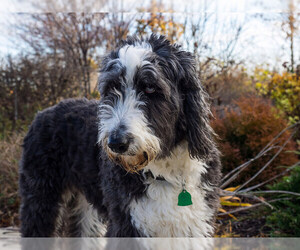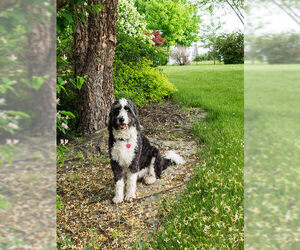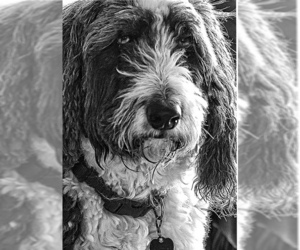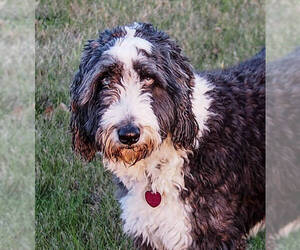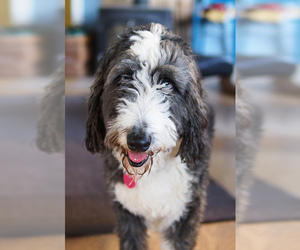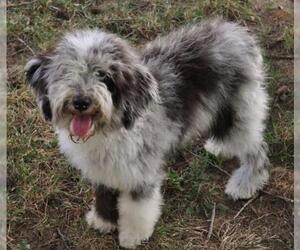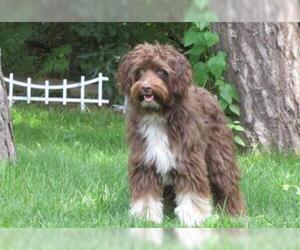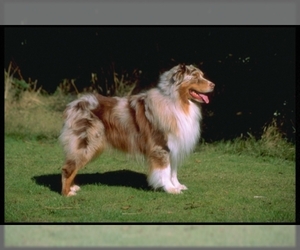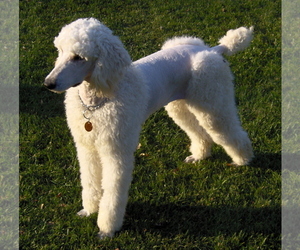All about Aussiedoodle dog breed
A.K.A. :Aussie-Poo, Aussiepoo
Aussiedoodle is a mix of
Size
Grooming requirements
Exercise requirements
Good with other dogs
Watchdog ability
Energetic
Training requirements
Playful
Affectionate
Good with other pets
Good with children
Good with strangers
Winter
Summer
Healthiness
Protective
Life Span
| Mixed Breeds | Member |
| Breeds A - Z | A |
| Breeds by Group | Companion Herding |
| Breeds by Trait | Good With Kids High Stamina Dog Breeds Hypoallergenic Low Shedding Smartest Dog Breeds |
| Overview: | The Aussiedoodle, a delightful cross between the intelligent Australian Shepherd and the elegant Standard Poodle, originated in the United States as a designer breed. These charming canines typically inherit a medium build, boasting a shaggy or wavy coat that comes in a myriad of colors, often with striking patterns reminiscent of their Aussie parent. Their temperament is generally described as friendly, intelligent, and highly energetic, making them a joy to train and an excellent companion for active families. Due to their need for mental and physical stimulation, they thrive best in homes with a yard and may find apartment living challenging without sufficient daily exercise. While generally healthy, potential owners should be aware of possible predispositions to conditions seen in their parent breeds, such as hip and elbow dysplasia, and certain eye conditions. Overall, the Aussiedoodle offers a wonderful blend of wit and affection for the right home. |
F.A.Q.
All You Need to Know About the "Aussiedoodle" Breed (parent breeds: "Australian Shepherd" × "Poodle (Standard)")
The Aussiedoodle, a captivating cross between the intelligent Australian Shepherd and the elegant Poodle (Standard), is a highly sought-after designer breed known for its charming personality and striking looks. Originating from the desire to combine the Aussie’s herding instinct and intelligence with the Poodle’s low-shedding coat and trainability, Aussiedoodles are typically smart, energetic, and affectionate companions. Their temperament often blends the playful nature of both parents, making them excellent family dogs who thrive on interaction and mental stimulation. Physically, they can vary, inheriting wavy or curly hypoallergenic-friendly coats, often in a kaleidoscope of colors including merle. While their moderate size makes apartment living possible with sufficient exercise, a home with a yard is ideal. They require regular grooming to prevent matting and consistent exercise, including walks, playtime, and engaging activities, to manage their energy and prevent boredom. Potential owners should be aware of common health considerations inherited from parent breeds, such as hip and elbow dysplasia, eye conditions, and certain genetic disorders, making reputable breeders crucial.The average Aussiedoodle weight for adults typically ranges from 40 to 70 pounds. There isn't a significant weight variation between male and female Aussiedoodles, with both sexes generally falling within this size spectrum. This healthy weight for Aussiedoodle is influenced by the size of the Poodle parent (Standard Poodle) and the Australian Shepherd. Potential adopters should consider this Aussiedoodle average size when looking for a medium to large dog.
Wondering about the Aussiedoodle height? You're in the right place! As a delightful cross between an Australian Shepherd and a Standard Poodle, the average size of an Aussiedoodle can vary, but we can give you a good idea of how tall is an Aussiedoodle typically.
Most Standard Aussiedoodles mature to an average height of 18 to 25 inches tall at the shoulder. This range reflects the sizes of their parent breeds. Generally, male Aussiedoodles might be on the taller end of this spectrum, while females tend to be slightly shorter, though individual genetics play a significant role. It's important to remember that these are averages, and a pup's final size can be influenced by the specific genetics inherited from each parent. For instance, if one parent was on the smaller side of its breed standard, their Aussiedoodle offspring might also be a bit smaller.When considering an Aussiedoodle, understanding their potential Aussiedoodle height is key to making sure they'll be a comfortable fit for your home and lifestyle!Aussiedoodle Colors: A Comprehensive Guide to Coat TypesAussiedoodles, a delightful cross between the Australian Shepherd and Poodle (Standard), boast a spectacular array of coat colors and patterns. Understanding these Aussiedoodle colors is crucial for potential owners, as they can influence appearance, rarity, and sometimes pricing. While the Aussiedoodle itself is a hybrid breed not officially recognized by the AKC, its parent breeds contribute to the wide spectrum of Aussiedoodle coat types.Common & Officially Recognized Parent Breed Colors:Many Aussiedoodle colors stem from the officially recognized colors of their parent breeds. You'll frequently find Aussiedoodles in solid colors such as Black, Chocolate (Brown), Cream, Apricot, and Red. These are often seen in Poodles and can be uniform throughout the coat. White markings, particularly on the chest, paws, and face, are also common, similar to those seen in Australian Shepherds.Patterned & Rare Aussiedoodle Variations:The true beauty and diversity of Aussiedoodle colors shine through in their patterned coats. The most iconic and sought-after pattern inherited from the Australian Shepherd is Merle. This includes Blue Merle (patches of grey/silver with black spots, often with tan points) and Red Merle (patches of lighter red/tan with darker red spots, often with tan points). Merle Aussiedoodles are highly desirable and often command a higher price due to their unique appearance.Other popular patterns include Phantom, which mimics the Doberman's marking pattern with tan points above the eyes, on the muzzle, chest, and legs, usually on a black or chocolate base. Bi-color (two distinct colors, often black and white or chocolate and white) and Tri-color (three distinct colors, typically black, white, and tan or chocolate, white, and tan) are also prevalent.Exotic Aussiedoodle Coat Types:For those seeking truly exotic Aussiedoodle variations, certain rare combinations can occur. These might include dilute colors like Blue (a dilute black, appearing as a dark grey) and Silver (a dilute black that lightens with age). Lilac (a dilute chocolate, appearing as a brownish-grey) is another rare and stunning color. While these dilute colors are beautiful, they are less common and may not be as robust in their genetic health background as standard colors, so always inquire about parent health clearances. Brindle (streaks of different colors, often black on a fawn or red base) and Sable (hair shafts with different colors, often darker tips on a lighter base) are also possible, though less frequent.When choosing an Aussiedoodle, remember that coat color is just one aspect. Focus on reputable breeders who prioritize health, temperament, and ethical breeding practices, regardless of the AKC recognized Aussiedoodle colors in their parent lines. The Aussiedoodle colors listed here represent the broad spectrum available, from classic to truly unique.
The Aussiedoodle personality is generally characterized by high intelligence, playfulness, and an affectionate nature. This hybrid often inherits the Australian Shepherd's strong desire to please and the Poodle's cleverness. They are typically very friendly and form strong bonds, making them incredibly loyal companions. Aussiedoodles are known for their high sociability, thriving on interaction with their human families and often getting along well with strangers, provided they are properly socialized from a young age.When it comes to children, Aussiedoodles are usually gentle and playful, making them excellent family pets, though supervision is always recommended with very young children due to their energetic nature. Their behavior with other pets is generally positive; they often adapt well to multi-pet households, especially if raised together.Regarding adaptability to apartment living, while their intelligence and desire for companionship make them adaptable, Aussiedoodles are energetic and require significant mental and physical stimulation. They are not ideal for sedentary lifestyles and will need daily walks, playtime, and engaging activities to prevent boredom and potential destructive behaviors. A house with a yard is preferable, but a dedicated owner committed to regular exercise and training can make apartment living feasible. Their temperament of Aussiedoodle is best suited for active individuals or families who can provide consistent training and ample opportunity for exercise and engagement.
The Aussiedoodle temperament blends the intelligence and trainability of the Australian Shepherd with the Poodle's playful and affectionate nature, resulting in a highly desirable companion dog behavior. They are typically very friendly and sociable, thriving on human interaction and often extending their warmth to strangers. This breed is known for its strong loyalty to its family, making them excellent, devoted companions. Aussiedoodles are generally quite adaptable; while they appreciate a yard for exercise, their moderate size and desire to be with their people can make them suitable for apartment living, provided they receive daily walks and mental stimulation. They are often wonderful with children, possessing a patient and playful disposition, and generally get along well with other pets, especially if socialized from a young age. While highly intelligent and eager to please, some Aussiedoodles may inherit a touch of the Australian Shepherd's independent streak, leading to occasional stubbornness during training, but they respond best to positive reinforcement. They can also be somewhat sensitive to harsh corrections, so a gentle yet firm approach is recommended. Overall, Aussiedoodles are intelligent, outgoing, and loving dogs perfect for active families seeking a devoted and engaging furry friend.
Aussiedoodle Care: Your Daily Maintenance GuideAussiedoodles are intelligent, active companions requiring consistent care. Grooming needs are significant due to their Poodle parentage; expect daily brushing to prevent mats and tangles, with professional grooming every 6-8 weeks for trimming and tidying. Their coats can range from wavy to curly, impacting the intensity of brushing needed. Exercise limitations are minimal; these are not "low-energy dog breeds." They thrive on at least 60-90 minutes of vigorous daily exercise, including walks, runs, and stimulating play, to prevent boredom and destructive behaviors. Dietary considerations involve a high-quality, balanced diet appropriate for their size, age, and activity level. Monitor food intake closely to prevent obesity, a common health concern. Regular dental care, including daily tooth brushing, is crucial to prevent periodontal disease. Aussiedoodles do not possess brachycephalic anatomy, so wrinkle and ear cleaning for that specific reason is not typically a concern; however, their floppy ears do require regular inspection and cleaning to prevent infections. Climate sensitivity is generally moderate; they can tolerate various climates but should be protected from extreme heat (due to their active nature and sometimes dense coat) and prolonged exposure to very cold temperatures. Common health concerns include hip and elbow dysplasia, eye conditions (PRA, cataracts), epilepsy, and certain skin issues like allergies. Regular veterinary check-ups are essential for early detection and management. How to care for an Aussiedoodle involves consistent training, socialization, and mental stimulation alongside their physical needs. For optimal health tips for Aussiedoodle, maintain their exercise routine, provide a balanced diet, and prioritize preventative veterinary care.
Aussiedoodle Activity Level: Moderately Active & EngagingHow active are Aussiedoodles? Aussiedoodles, a vibrant cross between the Australian Shepherd and Standard Poodle, possess a moderately active energy level that balances playful enthusiasm with a readiness to relax. They are not typically high-strung, but they are far from couch potatoes. Their daily exercise needs are significant, requiring at least 60-90 minutes of moderate-to-vigorous activity spread throughout the day. This could include brisk walks, jogging, playing fetch, or engaging in mentally stimulating games.Aussiedoodles love playtime! They thrive on interactive activities with their families and often enjoy puzzle toys, agility, or obedience training. They're intelligent and eager to please, making them excellent partners for various dog sports. However, due to their Poodle lineage, they are not brachycephalic (short-nosed) and therefore do not have limitations related to breathing difficulties during exercise. They can safely enjoy active play without the concerns associated with brachycephalic breeds.While Aussiedoodles certainly enjoy short bursts of energy and playful romps, they are also content to settle down for long periods of rest after their exercise needs are met. This adaptability makes them suitable for active families who can commit to their daily exercise requirements. They may be less suitable for low-energy households or those unable to provide consistent physical and mental stimulation, as boredom can lead to undesirable behaviors. Potential adopters seeking an engaging, intelligent, and affectionate companion will find the Aussiedoodle's activity level and playful nature a perfect fit.
To understand how to keep Aussiedoodle healthy, owners should maintain a lean body weight to reduce strain on hips and spine, provide balanced exercise without overexertion, clean and dry skin folds and ears regularly, monitor for allergy triggers, and avoid strenuous activity in hot weather. Routine veterinary checkups, especially for orthopedic and respiratory health, are essential for early detection and long-term management. With proactive care, adopters and buyers can ensure this affectionate and intelligent hybrid remains a strong, healthy, and happy companion.
Sources note that Aussiedoodles may also inherit breed-specific risks such as progressive retinal atrophy (PRA), epilepsy, and autoimmune disorders from their Australian Shepherd lineage, while their Poodle heritage adds risks of skin conditions and allergies. Preventive screenings, responsible breeding, and consistent veterinary monitoring are key to minimizing these risks and supporting long-term wellness.
Breed Breakdown: What Experts Say About the Aussiedoodle
I would rate the Aussiedoodle's "Size" trait a 6 out of 10.While an Aussiedoodle's size can vary due to the Poodle parent being either Miniature or Standard, when considering the "Standard" Poodle as specified, the Aussiedoodle typically falls into the medium-to-large category. They generally stand between 18 to 25 inches tall and weigh anywhere from 40 to 70 pounds, with some larger individuals reaching closer to 80 pounds. Their body structure is usually athletic and well-proportioned, reflecting the working heritage of both parent breeds.Compared to other companion dogs, they are definitely not a small lap dog, nor are they as massive as a Great Dane or Mastiff. They occupy a comfortable middle ground, making them too substantial for easy travel in carriers and often a bit large for very small apartments, especially without sufficient exercise. While they could adapt to apartment living with dedicated outdoor activity, they are best suited for households with a bit more space, such as a house with a yard, where they can stretch their legs and expel their energy. Their size makes them a sturdy companion for active families.
Rating: 8The Aussiedoodle generally lands on the higher end of the grooming spectrum due to its parent breeds' coats. The Poodle's influence often results in a curly or wavy, low-shedding (but not non-shedding) coat that is prone to matting without regular attention. The Australian Shepherd contributes to a dense undercoat and a need for thorough brushing to prevent tangles and remove loose hair. This combination means daily or every-other-day brushing is often necessary to prevent mats, especially in areas like behind the ears, armpits, and groin. Professional grooming every 6-8 weeks is typically required for clipping and trimming to maintain a manageable length and prevent severe matting. While they are often praised for being "low-shedding," this simply means the hair gets trapped in the coat and needs to be brushed out, not that it doesn't come out. Ear cleaning is crucial due to potential floppiness and hair growth within the ear canal, which can trap moisture and lead to infections. Nail trimming will be a regular need, as with most dogs. While not inherently prone to skin folds like some brachycephalic breeds, their dense coats can conceal skin issues if not properly groomed. Overall, Aussiedoodles require frequent and specialized grooming to keep their coats healthy and prevent discomfort, making them a higher-maintenance breed in terms of grooming compared to many other companion dogs.
I would rate the Aussiedoodle's exercise requirements as an 8 out of 10.This rating reflects the energetic and intelligent nature inherited from both parent breeds. Australian Shepherds are renowned for their high drive and need for a "job," while Standard Poodles are also active, athletic, and highly intelligent. An Aussiedoodle will typically require significant daily activity to stay healthy and mentally stimulated. This isn't a breed that thrives with minimal activity; they need structured routines that go beyond just a casual walk. They will benefit from at least 60-90 minutes of vigorous exercise daily, which could include brisk walks, jogging, hiking, extended play sessions (fetch, frisbee), or engaging in dog sports like agility, obedience, or flyball. Their high energy levels and excellent stamina mean they tolerate sustained movement well. Without adequate physical and mental stimulation, Aussiedoodles can become bored, destructive, or develop undesirable behaviors. They are not brachycephalic, so there are no respiratory limitations to consider, allowing them to excel in various types of strenuous exercise.
I'd rate the Aussiedoodle's watchdog ability as a 7 out of 10.Aussiedoodles inherit a blend of traits from their parent breeds that generally make them capable and effective watchdogs, though not typically aggressive. The Australian Shepherd contributes strong herding instincts, which include an innate alertness to their surroundings and a desire to "manage" their territory and flock (their human family). This translates into a dog that is often quick to notice unusual sights or sounds. The Standard Poodle, while sometimes perceived as less of a guard dog, is also an intelligent and observant breed, often quite sensitive to changes in their environment.This combination usually results in an Aussiedoodle that is very alert and will readily bark to signal the presence of unfamiliar people approaching the home or unusual noises. They are typically territorial enough to want to announce an intrusion, and their size (especially from the Standard Poodle influence) can add a deterrent factor. They are intelligent enough to differentiate between expected visitors and potential threats, though they may initially bark at all newcomers. While they might not be the type of dog to physically confront an intruder aggressively, their consistent and often loud barking serves as an excellent early warning system, making them more than a passive companion and certainly capable of providing meaningful alerts in a home environment.
Rating: 8/10The Aussiedoodle, inheriting traits from both the Australian Shepherd and the Standard Poodle, generally possesses a high degree of sociability with other dogs. Both parent breeds are known for their intelligence and desire to please, which translates into a trainable and adaptable demeanor in their offspring. Aussiedoodles typically exhibit a friendly and curious nature around unfamiliar dogs, often approaching with an eagerness to play. They tend to be compatible with dogs of various sizes and energy levels, as long as they've been properly socialized from a young age. Their playful energy often makes them ideal companions for other active dogs, and they can adapt well to more laid-back canine housemates with appropriate management. While early and consistent socialization is crucial, as it is with any breed, Aussiedoodles are not typically prone to aggression or dominance. They generally thrive in multi-dog households and enjoy the companionship, though careful introductions and continued training are always recommended to ensure peaceful coexistence, especially when integrating new dogs or navigating strong personalities. With proper guidance, they are generally a joy to have in a canine-inclusive environment.
I would rate the "Energetic" trait of the Aussiedoodle at a 9.The Aussiedoodle is a highly energetic breed, inheriting its zest for life from both its Australian Shepherd and Standard Poodle parents. They typically possess a high activity level, displaying significant endurance and a strong desire for play. These dogs are not content to lounge around all day; they thrive on physical stimulation and require ample opportunities for exercise to prevent boredom and destructive behaviors. They excel in outdoor and athletic activities, often enjoying sports like agility, flyball, and hiking. Their natural inclination is to be very active and engaged, making them far from laid-back compared to most companion dogs.It's important to note that the Aussiedoodle is not a brachycephalic breed, meaning they do not have the shortened snout characteristic of breeds like pugs or bulldogs. Therefore, their anatomy does not typically impose limitations on their stamina or exercise tolerance. Their well-proportioned snouts allow for efficient breathing, enabling them to comfortably participate in prolonged physical activity without the respiratory difficulties that can affect brachycephalic dogs.
I'd rate the "Training Requirements" of the Aussiedoodle a 7 out of 10. While incredibly intelligent due to both parent breeds, the Australian Shepherd's strong herding instincts and the Poodle's surprising capacity for independent thought mean they're not a "train themselves" dog. They are highly responsive to commands when engaged, but their intelligence can also lead to boredom if training isn't varied and stimulating, making them seem stubborn. Their attention span is generally good for focused tasks, but without consistent mental and physical exercise, they can become easily distracted or find their own (often mischievous) ways to entertain themselves. They thrive on consistency and positive reinforcement, quickly learning what's expected. However, due to their potential for high energy, smarts, and a touch of independent thinking, they are generally not considered a beginner-friendly breed. They require an owner who is committed to structured routines, ongoing mental stimulation, and consistent, firm (but always positive) guidance to channel their considerable abilities effectively. An experienced owner will find them a joy to train and incredibly rewarding, but a novice might struggle with their drive and smarts without professional help.
I would rate the Aussiedoodle's "Playful" trait a strong 9 out of 10.Aussiedoodles inherit a wonderful blend of energy and enthusiasm from both their Australian Shepherd and Standard Poodle parents. They are naturally spirited and highly active dogs that thrive on interaction and engagement. Expect them to be incredibly enthusiastic about playtime, whether it's chasing a ball, playing tug-of-war, or engaging in more structured training games. Their intelligence means they often enjoy mentally stimulating toys and activities as well as physical ones. They love to be involved in family life and can exhibit attention-seeking behaviors when they desire interaction, often nudging or bringing toys to encourage play. While they can have an "off switch" after sufficient exercise, their baseline is energetic and fun-loving, making them a fantastic choice for active families who enjoy incorporating their dog into daily activities. They are rarely laid-back compared to many other companion breeds; instead, they exude an infectious zest for life.
I would rate the Affectionate trait of the Aussiedoodle a 9 out of 10.Aussiedoodles are renowned for their highly affectionate and people-oriented nature, often described as "Velcro dogs." They possess a strong desire for human companionship and thrive on being an integral part of the family's activities. Physical closeness, such as cuddling, leaning, and lap-sitting, is a common and cherished behavior, and they often follow their owners from room to room, seeking to be involved. Their loyalty is deep-seated, and they are generally very sensitive to their owner's emotions, offering comfort and mirroring moods. Compared to more independent breeds, Aussiedoodles actively seek out and revel in affection, relying on it for their emotional well-being and forming very strong bonds with their human companions.
I'd rate the "Good with Other Pets" trait of the Aussiedoodle a 7 out of 10.Aussiedoodles generally inherit a good foundation for sociability from both parent breeds. Australian Shepherds are often known for their loyalty and ability to coexist, and Poodles, especially Standard Poodles, are intelligent and generally even-tempered. This combination often results in an Aussiedoodle that, with proper socialization, can be quite friendly and adaptable in multi-pet households. They typically have a moderate prey drive; while the herding instinct from the Australian Shepherd might manifest as a desire to "herd" other pets, this is usually not aggressive and can often be redirected or managed with training. Resource guarding tendencies are not inherently high but, as with any breed, can develop if not addressed early.However, the rating isn't a 10 because while they have the *potential* to be extremely pet-friendly, it's not always a completely natural, hands-off outcome. Early and consistent socialization is crucial. Without it, the herding instincts might be overwhelming for smaller, more timid pets, or their playful energy might be too much for older animals. Supervision is always recommended, especially during initial introductions or with significantly smaller pets. They aren't inherently incompatible, but they do require a committed owner to guide them toward peaceful coexistence rather than simply being born with it.
Rating: 8/10The Aussiedoodle, a cross between the Australian Shepherd and the Poodle (Standard), generally inherits a wonderful blend of traits that make them highly suitable for families with children. They are often described as intelligent, playful, and affectionate, with a strong desire to be part of family activities. Their Poodle lineage contributes to a patient and gentle nature, while the Australian Shepherd brings an energetic and loyal disposition. They are typically tolerant of the noise and activity that comes with children, and their eagerness to please makes them highly trainable, which is crucial for successful integration into a family setting. While generally naturally gentle, like any breed, early socialization and consistent positive reinforcement training are essential to ensure they develop into well-mannered companions. Supervision, especially with very young children, is always recommended to teach both the dog and the child appropriate interactions, but the Aussiedoodle's inherent good nature often means they thrive in a family environment and form strong bonds with their human siblings.
The "Good with Strangers" trait for an Aussiedoodle, a cross between an Australian Shepherd and a Standard Poodle, would generally rate around a 7 out of 10.Aussiedoodles tend to be quite sociable and friendly, inheriting the Poodle's often outgoing nature and the Australian Shepherd's desire to be part of the family. They are typically curious and, with proper socialization, enjoy meeting new people. They are less likely to be overtly aggressive or highly reserved compared to some guarding breeds. While they may initially be a little watchful or reserved with an unfamiliar person entering their home, this often quickly gives way to a wagging tail and a desire for attention once they've assessed the individual as non-threatening. They are generally adaptable in public settings and, thanks to their intelligence, can be trained to be comfortable and polite around guests. However, it's important to note that the Australian Shepherd side can sometimes introduce a slightly more reserved or even "herding" tendency, meaning some individuals might be a bit more aloof or prone to "herding" strangers initially. While naturally inclined to be friendly, consistent socialization from a young age is crucial to ensure they develop into the extremely welcoming dogs they have the potential to be, preventing any potential shyness or excessive barking due to lack of exposure.
Rating: 8The Aussiedoodle, a cross between the Australian Shepherd and the Standard Poodle, generally possesses a good tolerance for winter conditions. Both parent breeds are active, medium to large-sized dogs with coats that offer a degree of insulation. The Aussiedoodle's coat, inheriting traits from both, is typically medium in length and can be wavy to curly, providing a decent barrier against the cold. They are not a brachycephalic breed, meaning they don't have the respiratory issues that can be exacerbated by cold air. Their active nature and lean, athletic build, while not boasting excessive body fat, mean they generate a good amount of body heat through movement. They enjoy outdoor activity and can safely engage in it in cold climates, often relishing the opportunity to play in the snow.Compared to other companion dogs, Aussiedoodles don't usually require extraordinary special care during winter months. However, it's still crucial to be mindful of extreme temperatures and prolonged exposure. While they can handle being outside for extended periods for exercise, they shouldn't be left unsupervised in freezing temperatures for hours on end, especially in very windy conditions. For very short-haired Aussiedoodles or those with a very thin Poodle-like coat, a sweater or coat might be beneficial during exceptionally cold or wet outings, particularly for older or very young individuals. Like all dogs, their paw pads should be checked regularly for ice buildup or irritation from salt and de-icers. Overall, with reasonable precautions and awareness of individual dog's limits, the Aussiedoodle is a robust and winter-hardy companion.
I'd rate the "Summer" tolerance of the Aussiedoodle at a 6.The Aussiedoodle, inheriting traits from both the Australian Shepherd and the Standard Poodle, generally possesses a moderate level of heat tolerance. Neither parent breed is brachycephalic, meaning they do not have the inherent breathing difficulties that would immediately put them at a higher risk for heatstroke. Their longer muzzles allow for more efficient panting, which is their primary method of cooling. However, both breeds typically have a dense coat, even if the Poodle's is non-shedding. This double coat, especially in the Australian Shepherd lineage, can trap heat, making them susceptible to overheating during prolonged exposure or strenuous activity in hot weather. While they can regulate their body temperature reasonably well under normal circumstances, their energy levels, particularly from the Australian Shepherd side, often lead them to push themselves, increasing their risk of heatstroke if not monitored.Compared to other companion dogs, Aussiedoodles do require special care in summer months. While not as delicate as a Bulldog, they are not as resilient as a short-coated, desert-adapted breed. Owners should be vigilant about avoiding peak sun hours for walks and exercise, providing ample shade and fresh water, and considering cooling vests or professional grooming to keep their coats shorter during the hottest periods. Indoor climate control is highly recommended during extreme heat to ensure their comfort and prevent overheating, even during periods of rest. They can enjoy outdoor activities, but these should be carefully managed to prevent overexertion in warm temperatures.
I would rate the Aussiedoodle's "Healthiness" trait a 7 out of 10.Aussiedoodles generally benefit from the hybrid vigor often seen in first-generation crosses, which can reduce the incidence of some single-gene recessive disorders prevalent in their parent breeds. Both Australian Shepherds and Standard Poodles are intelligent and active breeds, and their offspring tend to inherit a good level of resilience and a decent life expectancy (typically 10-14 years).However, they are not without potential health concerns, largely reflecting those of their parent breeds. Aussiedoodles can be predisposed to hip and elbow dysplasia, eye conditions like progressive retinal atrophy (PRA) and cataracts (from both sides), and certain sensitivities to medications (MDR1 gene, particularly from the Australian Shepherd). Bloat is also a concern due to their larger size and deep chest, inherited from the Poodle. Skin allergies can also appear.While not considered high-maintenance in terms of needing constant vet intervention for chronic issues, they do require consistent preventive care, including regular exercise to maintain joint health and weight, a high-quality diet, and routine veterinary check-ups to screen for potential problems. Responsible breeding, including genetic health testing of the parent Australian Shepherds and Standard Poodles for known breed-specific conditions, significantly impacts the health and reduces the likelihood of these issues in the Aussiedoodle offspring. They are generally robust compared to many brachycephalic or extremely toy breeds, but their active nature and genetic heritage mean owners need to be proactive about their health.
I would rate the "Protective" trait of the Aussiedoodle a 6 out of 10.While not typically considered a guard dog, the Aussiedoodle inherits a moderate degree of protective instincts from its parent breeds. The Australian Shepherd contributes a strong sense of loyalty, alertness, and a natural inclination to be aware of their surroundings and their "flock" (family). This translates to them being generally good watchdogs, often barking to alert their owners to new sights or sounds, including approaching strangers. They are highly devoted to their families and will often position themselves between their loved ones and perceived threats, demonstrating a willingness to stand their ground.However, the Poodle influence tempers this protective drive. Standard Poodles, while intelligent and often wary of strangers initially, are not inherently aggressive or overly territorial. They tend to be more focused on companionship and are generally quite social once they determine there's no threat. This means that while an Aussiedoodle will likely be a good alert system and show loyalty, their reaction to strangers is more often characterized by an initial cautiousness that can transition to friendly curiosity rather than outright aggression or a readiness to physically defend. They are more likely to deter an intruder through their watchful presence and barking than to engage in a confrontation. Therefore, the Aussiedoodle is more of a companion dog with excellent watchdog capabilities rather than a true guard dog capable of offering meaningful physical protection in a household setting beyond an alarm system.
I would rate the Aussiedoodle's "Life Span" trait a 7.The Aussiedoodle generally enjoys an average to slightly above-average lifespan compared to many other companion dog breeds, typically ranging from 10 to 14 years. This rating reflects the influence of both parent breeds. Standard Poodles are known for their good longevity, often living 12-15 years or more, while Australian Shepherds usually fall within the 10-13 year range. The hybrid vigor often seen in first-generation crosses can sometimes contribute to better overall health and a slightly longer lifespan by reducing the expression of recessive genes for certain diseases.However, Aussiedoodles are still susceptible to some health issues inherited from their parent breeds, which can impact longevity if not properly managed. These include hip and elbow dysplasia, certain eye conditions (like progressive retinal atrophy and cataracts), and potentially some autoimmune diseases or epilepsy. Responsible breeding practices, including health testing of parent dogs, are crucial to minimize the risk of these genetic predispositions. With proper nutrition, regular exercise, routine veterinary care, and a loving environment, an Aussiedoodle can certainly live a full and healthy life on the longer end of their typical range.
Aussiedoodle Puppies for saleSee all puppies for sale
Aussiedoodle Dogs for adoptionSee all dogs for adoption
Aussiedoodle BreedersSee all breeders
Similar Dog Breeds for Aussiedoodle
Quick Breed Selector 0 - not important, 1 - smallest, 10 - largest
Variants & Mistakes :Ausiedoodle, Austiedoodle, Aussiedoodel, Aussiedodle, Aussiedooodle, Aussi-doodle, Aussie dooodle, Austrailiandoodle, Australiandoodle, Australianedoodle, Austrailian doodle, Austrailian doddle, Aussiepoo, Austrailian poo, Ausiedoodl, Ausidoodle, Audiedoodle, Austrailadoodle, Austrelidoodle, Ausiedodel, Auziedoodle, Oussiedoodle, Ousiedoodle, Auseedoodle, Ausidoodl, Ausiedooodle, Ausidudel, Ausidodle, Ausedoodle, Ausiedude, Austadoodle, Austidoodle, Austrdoodle, Austridoodle, Austredoodle, Austriandoodle, Ausdoodle, Ausedoodl, Austaladoodle, Ausydoodle
